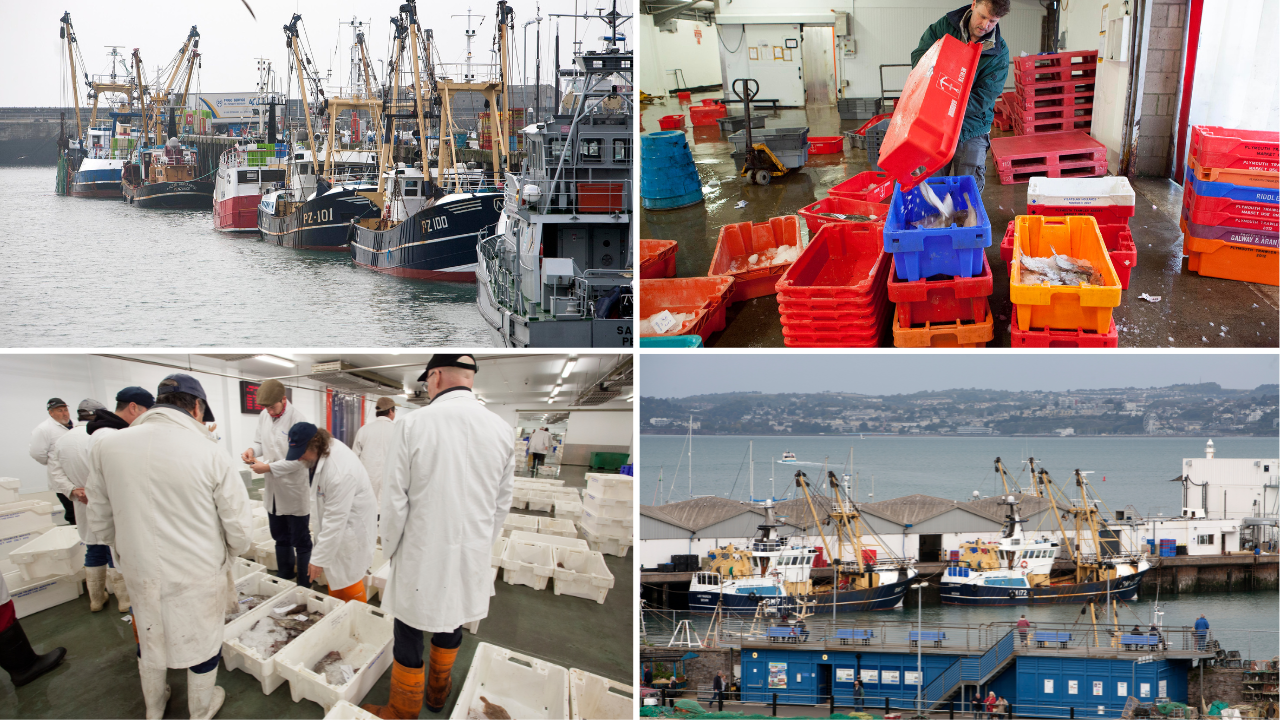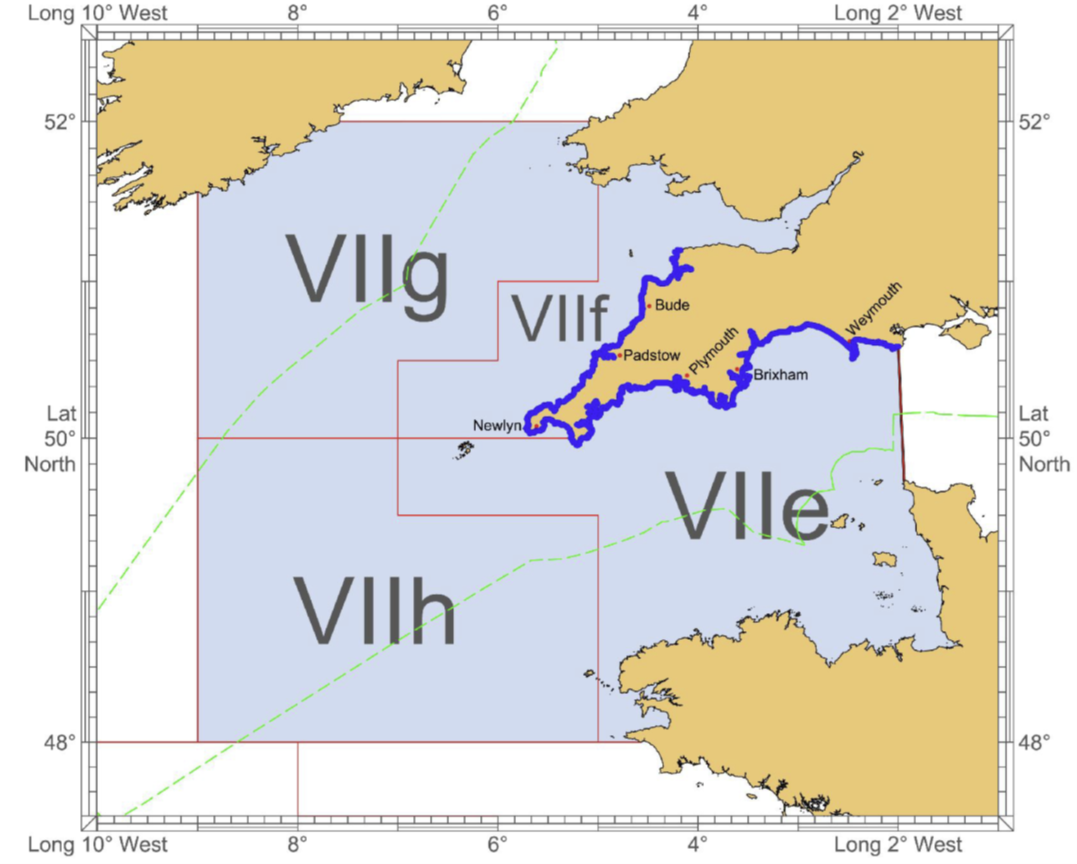A tool to help manage Southwest England fisheries
Fisheries management is vital to ensure the sustainability of seafood and protect seabed habitats and the animals that live there. It’s not a one size fits all approach. There are different tools and frameworks which can be used to support management in different types of fisheries.
I’ve been working with partners and the local industry in Southwest England on an Ecological Risk Assessment (ERA). In this blog I’ll explain the value of the ERA tool, what it means for improved management of important fisheries in the region and what we’re going to do next.

What is an ERA?
An ERA is a tool which can be applied to data limited wild capture fisheries. It is used to assess the risks that fishing poses to an ecosystem within a defined area.
Specifically, an ERA focuses on:
- target commercial fish species
- non-target species such as fish bycatch
- seabirds and marine mammals
- the impact of fishing on benthic (seabed) habitats
Risks identified can simply reflect that we don’t know enough about a fishery. If that’s the case, a risk score could be reduced by improving monitoring and increasing data collection and research. However, there could also be a genuine risk to a species or a habitat from fishing, in which case action should be taken to mitigate the risk.
We’ve been using ERAs in the Southwest England mixed fishery to help understand the state of these fisheries and drive improvements for almost 10 years. With the support of Southwest stakeholders, we recently updated the ERA and developed an action plan to set out how we will tackle the high risk areas.
Why are we using an ERA for Southwest fisheries?
In 2013/14 we carried out an initial ERA in collaboration with seafood businesses to assess the ecological effects of commercial fishing in the Southwest of England.
The project was initiated because of concerns that a significant number of the species commercially fished were data limited. This included megrim, john dory, sardines, sprat, monkfish, turbot, brill and bream. They were unlikely to be candidates for full ICES stock assessments or Marine Stewardship Council certification because of their size and value.
The seafood supply chain was also looking for evidence and reassurance that these fisheries were being sustainably managed. Data limited, non-quota species – those without a quota or full stock assessment – make up almost 50% of the value of landings by the Southwest fishing fleet. They are also a key source of supply for processors in the area.
The initial ERA acted as a catalyst for a programme of fisheries management initiatives in the area. This included:
- Fisheries Improvement Plans for monkfish, scallops, crab and lobster
- the spurdog bycatch avoidance programme
- improved data collection for demersal and pelagic species as part of Fisheries Science Partnerships
Although management action was taken and improvements were made since the initial ERA, there were still issues associated with these fisheries. Due to the data deficient nature of these stocks a comprehensive management plan was not feasible, so industry stakeholders were in favour of updating the ERA. So, in 2019, the Seafish Southwest Advisory group identified updating the Southwest ERA as a priority action.
How was the updated Southwest ERA delivered?
Work on the updated Southwest ERA began in 2020. A Client Group consisting of industry representatives from across the supply chain was established. It’s role was to steer the ERA process, ensuring that it met the needs of the stakeholders in the Southwest. We also engaged Inmara Ltd to support the project.
The updated ERA focused on the impact that fishing is having on key non-quota species and the wider marine environment. It used three risk assessment tools:
- Productivity Susceptibility Analysis (PSA) – was applied to determine the risk of impacts of fishing on commercial species, which are not otherwise subject to analytical stock assessment.
- Consequence Spatial Analysis (CSA) – was applied to determine the risk of impacts of mobile fishing gear on seabed habitats.
- Scale Intensity Consequence Analysis (SICA) – was used to rank the relative risks of impacts of fisheries on protected species.
Detailed assessments were compiled by applying the tools above to the best available evidence.
An Expert Panel, chaired by Dr Geoff Tingley, was also established to provide technical expertise to underpin the risk assessment material. The panellists were chosen for their expertise in fisheries science, management, environmental interactions, knowledge of Southwest fisheries, and the seafood supply chain. The risk scores and assessments made by the Expert Panel are detailed in the ERA report.

What did we learn?
The updated Southwest ERA has given us a better understanding of the relative risk that fishing has on commercial and non-commercial fish species, habitats and endangered, threatened and protected (ETP) species. Some of these risks reflect the need for more urgent management action, while others reflect the lack of available data.
Risk to commercial fish species
The ERA results clearly identify that there are some potentially high-risk interactions between fishing activity and commercial fish species which are not yet subject to routine, robust analytical stock assessments. The commercial species ranked as high risk are:
- cuttlefish
- mixed ray species
- dab
- pouting
The high-risk ratings assigned to mixed ray species reflects the low productivity of the species. Cuttlefish, dabs and pouting are productive species, but have high-risk scores because they have a high susceptivity to capture. For commercial species, the risk ranking can be used to help prioritise future data collection and analytical stock assessment work.
Risk to benthic habitats
The ERA identified that there are potentially high-risk interactions between mobile fishing gear used and seabed habitats. These interactions are primarily caused by fishing methods such as demersal trawls, beam trawls and dredges. These fishing methods have the greatest potential to impact on sensitive marine ecosystems. These high-risk interactions warrant further investigation to better understand the extent and nature of the risk and, if necessary, to inform the development of appropriate mitigation.
Risk to ETP species
The ERA identified the relative risks of the interactions between fishing activity and ETP species. The results are not unexpected and show that fixed nets pose the greatest potential risk to the protected species scored. This includes several bird species and marine mammals. The management objective for many of these species is to minimise or eliminate unwanted catches, so the risk ranking provides a means to prioritise future monitoring and mitigation efforts.
How does this benefit the catching sector and the supply chain?
Improving the risk scores of species categorised as high risk will have a benefit to the provenance of all species caught as part of the mixed fishery. This will help provide assurance to the supply chain that Southwest fisheries are addressing the impact of fishing on fish stocks, habitats and ETP species. The work carried out in the Southwest can also provide a blueprint for similar assessments in other fisheries around the UK.
What are the next steps?
When the ERA report was finalised the Client Group reconvened to support the development of an Action Plan. This plan will help to address the high-risk scores over the next 3-5 years. It has been informed by the severity of the risk score, commercial priorities, and supply chain interest.
Action Plan work packages will focus on delivering robust and credible information to provide responsible sourcing assurance to the processing, retail and foodservice sectors. The ERA also has an important role in supporting the ambition of increasing local consumption of UK landed seafood.
Goals for the Action Plan in 2023 are to:
- review all available data on Southwest fisheries
- improve the assessment of benthic fishery footprints and gear interactions with ETP species
- investigate the potential to carry out full stock assessments on high-risk species
We will also explore if some underutilised species could find a way onto consumers plates if there was better evidence on the long-term sustainability of these fisheries.
The Client Group will oversee the delivery of the Action Plan. They will ensure that any work undertaken results in tangible benefits, not only to the Southwest industry but throughout the supply chain.
Find out more
You can download a copy of the Southwest ERA Action Plan from the link below:
For more information about our work on the ERA or to request a copy of the full technical report please contact me on Gus.Caslake@seafish.co.uk.
More information on tools for fisheries management and on fish stock assessment and management is available from the links below: